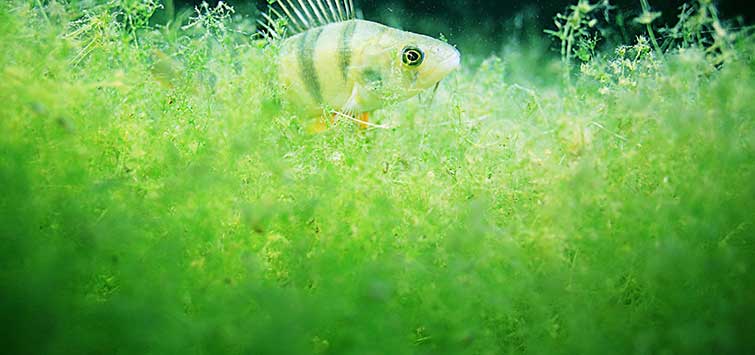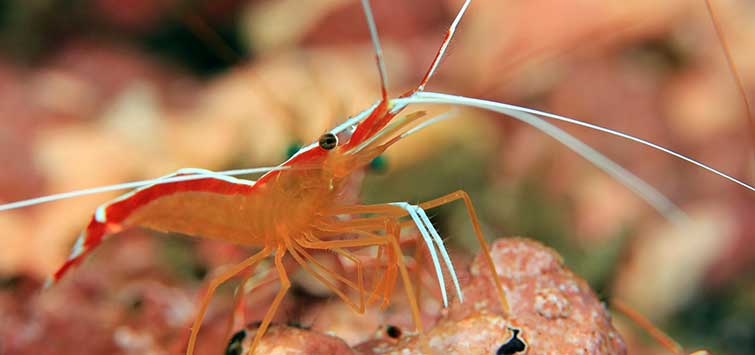The Skeptical Fishkeeper: Algae, Part 2: Getting Rid of the Stuff
Author: Laura Muha
Last month I described an algae problem that was making one of my tanks look grungy, and I said I’d decided it was time to get to the bottom of the problem. I spent most of that column discussing basics—what algae are and the things that fuel their growth—on the theory that if you want to solve a problem it helps to learn as much about it as you can. But this month it’s time to get down to the nitty-gritty: How do you get rid of the darn stuff?
Knocking Out Algae
Although there are commercial products you can add to your tank water to kill algae in one fell swoop, I’m not going to talk about them here for a couple of reasons. First, although most such products are technically “fish safe,” anything you add to your water causes some level of osmotic stress for your fish. That’s why my fishkeeping philosophy has always been “don’t add anything to the tank water if you don’t have to.” And when it comes to algae, you shouldn’t have to add anything as long as you’re willing to make some adjustments in your husbandry practices (more on that later).
It’s also important to realize that if you have algae overgrowth in a tank, there’s an underlying reason for it, such as a buildup of organic compounds in the water. Using an algaecide without addressing the root of an algae problem is the aquatic equivalent of taking an aspirin to soothe a toothache without treating the abscess that’s causing it. In the short run the pain might subside, but in the long run you’re going to have an even bigger problem on your hands.
So instead of talking about algaecides, I’d rather focus on the questions you can ask yourself to figure out what’s going on in your tank and to make some simple husbandry changes that, in my experience, can go a long way toward solving an algae problem. Ready? Let’s get started.
What’s the Organic Load in the Tank?
In order to have an algae outbreak you need three things: algae spores or cells, environmental conditions that encourage their growth, and something for them to eat (or, more accurately, to use as a fuel source). You can’t avoid the first factor; algae are everywhere, even in the air you breathe. I’ll get to the second in a minute, but for now, let’s consider the last factor. And that means breaking out your water test kit, because algae’s favorite fuels are organic compounds such as ammonia and nitrates (which shouldn’t be a surprise, since both are often components of fertilizer).
Watch Out for Ammonia
If your tank has been established for a while, there shouldn’t be even a trace of ammonia in it; if there is, it could indicate that you’re overstocking or overfeeding to the point where the biofilter can’t keep up, or that there’s a dead fish somewhere in the system. Regardless, the presence of ammonia in a cycled tank indicates that you have a bigger problem than algae to worry about, and you need to get to the bottom of it right away.
Nitrates
But nitrates are another story, because the longer a tank has been set up, the more likely they are to build up in the water. Overstocking and overfeeding can play a role, but so can not keeping up with water changes. Although the experts I’ve talked to for past columns disagree on a “safe” level of nitrates in a fish tank—recommendations range from under 25 ppm to 80 ppm—it’s probably safe to say that if the readings are consistently on the high end of that range, nitrates are a contributing factor in your algae outbreak and water changes are part of the solution.
Phosphates
You should also test your tank water for phosphates, another favorite fuel for algae; many municipalities add them to the water supply to prevent pipe corrosion, and they’re also an ingredient in some fish foods and some marine salt mixes. Like nitrates, phosphates are best removed via water changes, but you can also buy phosphate-adsorbing media for your filter.
How Much Light Does Your Tank Get?
This is a bit of a trick question, since different species of algae like different levels of light. Some, such as the free-floating planktonic algae that cause green water, need bright light and are most often found in tanks that are exposed to direct sunlight. But other species of algae, including some diatoms, thrive in low light.
I was fairly certain light was playing a significant role in the algae problem in my tank, because when I studied their growth patterns I noticed that they were heaviest by far in the brightest areas of the tank. On the live rock, for instance, algae were growing only along the ridges closest to the light; the rest of the rock was clear.
I also had to admit that the tank was getting way too many hours of artificial light each day, because I often forgot to turn the tank lights off, or wasn’t home to do it. As a result the lights sometimes stayed on for a dozen or more hours, something that wasn’t necessary in a fish-only system. (If your tank contains plants or coral, you obviously have to take their needs into account when adjusting the lighting, but in such tanks algae is less likely to be a problem because the other photosynthetic organisms out-compete the algae for nutrients.)
On a side note, if you carefully control your tank lights but still have a lot of algae, you might want to ask yourself if it’s possible that your tank is getting more light than you think. I once set up a freshwater tank in a location I was confident wouldn’t get much sun, and it didn’t—in the winter. But six months later, when summer rolled around and the sun got higher in the sky, the light shifted, and one end of the tank got a couple of hours of sunlight every day, something I didn’t realize at first because I was rarely in that room during the hours that the sun was hitting the tank. I did, however, start to suddenly notice more algae in that tank, and when I finally figured out what the problem was, I solved it by covering one end of the tank with a towel to block the sunlight.
When Was the Last Time You Replaced Your Tank Lights?
Even if your aquarium isn’t getting an excessive amount of light (artificial or otherwise), it might be worth changing the bulbs in your tank lights. That’s because different types of algae thrive on different wavelengths of light, and the wavelength of most bulbs changes over time. For that reason some experts recommend changing fluorescents once a year and VHO lamps at least twice a year.
In addition, many species of algae seem to like blue light, so replacing actinic bulbs with those of another spectrum sometimes helps (assuming, of course, that you aren’t trying to grow plants or coral that require blue light).
What’s the Temperature of Your Water?
Just as each algal species has a preferred light spectrum and level, it also has a preferred temperature range. While algae are found under all conditions in nature—a couple of years ago many pondkeepers in my area noted thick green mats of algae forming under the ice in our backyard ponds in February—most species seem to multiply fastest in warm water. So adjusting the temperature downward a couple of degrees (as long as it remains in the appropriate range for your fish) can sometimes slow an algae outbreak.
Is Your Tank Getting Enough Aeration?
If not, the level of carbon dioxide in the water may be on the high side; and algae, like other photosynthesizing organisms, love CO2. In addition, aeration encourages the growth of aerobic bacteria, which can out-compete the algae for some of the nutrients in the tank. And it can help keep debris from settling to the bottom of the tank; if the debris remains in circulation, it’s more likely to get filtered out of the water.
As a side note, I’ve seen the impact of adding aeration first-hand in a tanks housing shell-dwelling cichlids. They’re very territorial little fish, and rarely venture more than a couple of inches from their shells which, obviously, sit on the bottom of the substrate. It’s not a coincidence, I’m sure, that in that tank the only place algae built up significantly was on the glass along the bottom 2 inches of the tank, because it was impossible to gravel vac among the shells, and nutrients tended to concentrate there. So I tried adding a couple of airstones near the bottom of the tank, and noticed that after that the algae growth lightened up.
Now What?
I started my algae investigation expecting to find a single, obvious culprit that I could blame for my algae problem. What I found, however, was that with the exception of the tank lights, which were staying on way too long, there wasn’t one obvious factor, just a bunch that applied in small ways to my tank.
For instance, the tank didn’t have much of a phosphate or nitrate problem—the nitrates were about 10 ppm and the phosphates were under 0.5 ppm, both the lowest detectable levels on the test strips. On the other hand, the algae had to be consuming something, so I couldn’t ignore the possibility that one reason the organics were low might be because a lot of them were getting sucked up by the algae.
In addition, I hadn’t replaced the bulbs in my tank lights at all in the two years that the tank had been set up, and one of them was an actinic bulb because I liked the way it looked. The water temperature was 79° F, toward the high end of the recommended range, because the heater wasn’t very adjustable; no matter what I set it at, the temperature didn’t drop. And the only aeration in the tank was coming from the filter. (If I had a reef system, I would have installed powerheads at strategic locations in the tank to keep the water circulating around the coral, but mine is a fish-only system, so I hadn’t bothered.)
Little Changes
In other words, there were lots of small changes I could take that might have an impact on the algae in the tank. However, if I fixed everything all at once, I’d never know which factors were contributing most. Plus, the algae were providing a form of “vegetable filtration” in the tank; I wanted to eliminate it slowly to give the beneficial bacteria in the biofilter time to pick up the slack.
So I started by pulling out my algae scraper and giving the tank walls a really good cleaning. Then I did a water change to get the already low level of organics in the tank even lower. I also turned the protein skimmer up a notch, a measure that doesn’t apply to a freshwater tank, and added some phosphate-adsorbing media to the filter. (Had the source of the phosphates been my tap water, I would have had to consider using RO water, but happily it wasn’t.)
The only other change I decided to make immediately was to shorten the tank’s photoperiod to nine hours a day—and to buy a timer for the lights to take over for my faulty memory.
Impressive Results
I stopped there, wanting to see what impact those changes would have on the algae situation, and I am happy to report that there was an immediate difference: the algae didn’t grow back on the front glass the way it had before, and soon it began to thin out from the spine of the live rock, too.
It’s not entirely gone, so I may still replace the bulbs in the tank lights, and maybe I’ll replace my heater, too. They’re small steps—but if there’s one thing I’ve learned, it’s that when it comes to algae, little things can go a very long way.

.png?h=595&iar=0&w=2781&hash=5FD5E69473BCC22199FBFA2FB71B6033)









